Wilson Dynapower Forged Irons Review
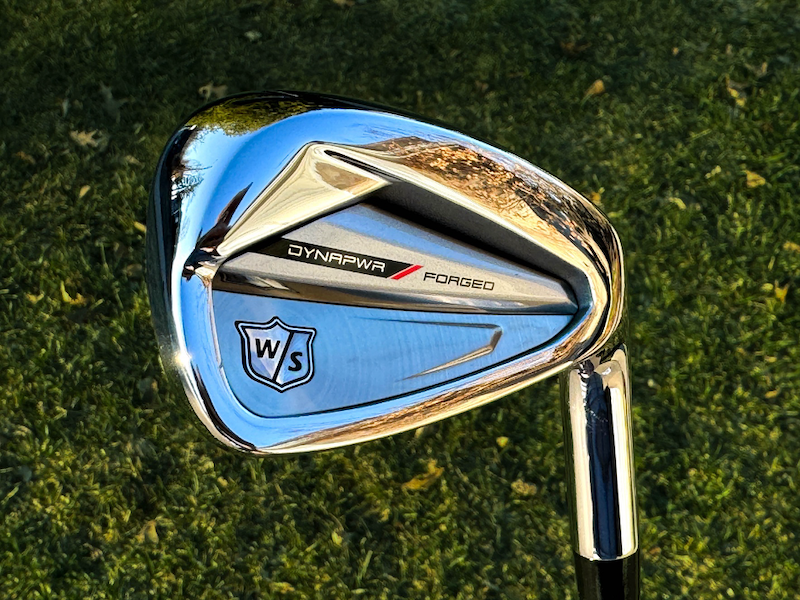
A year into their reimagined Dynapowr campaign, Wilson Golf has dropped a full line of metalwoods, a set of game improvement irons, and just a few weeks ago announced the new Staff Model CB and Blade irons. That’s a bunch of golf clubs, but there was still a hole in the lineup for players looking for enhanced forgiveness and distance in a smaller-sized iron. The so-called “players distance” category is incredibly popular this day and age, but last year’s Dynapower irons didn’t really check the necessary boxes to qualify. Luckily for Wilson fans, the company’s final piece of the puzzle is here – the Dynapower Forged irons.
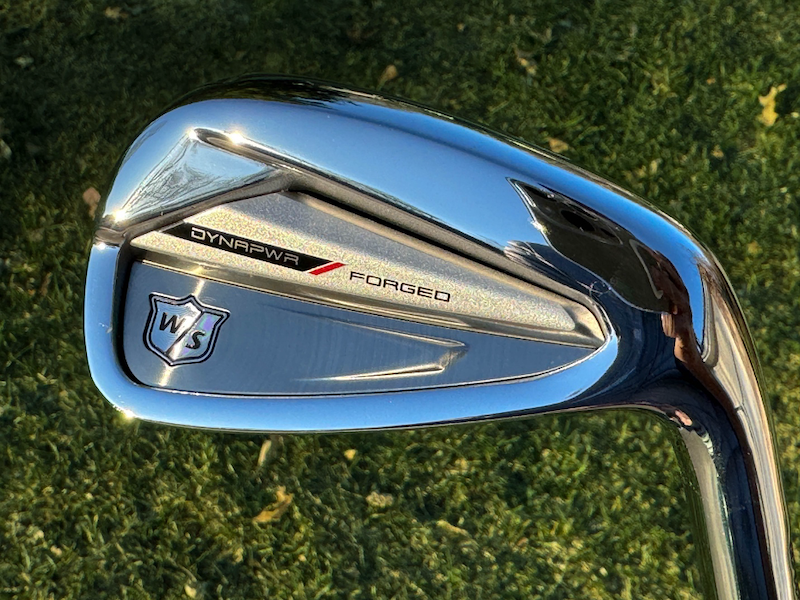
According to the Wilson, the Dynapower Forged irons, “are designed for players who are looking for the best of both worlds – a compact head shape and sophisticated design, without wanting to sacrifice both powerful distance and pinpoint accuracy.”
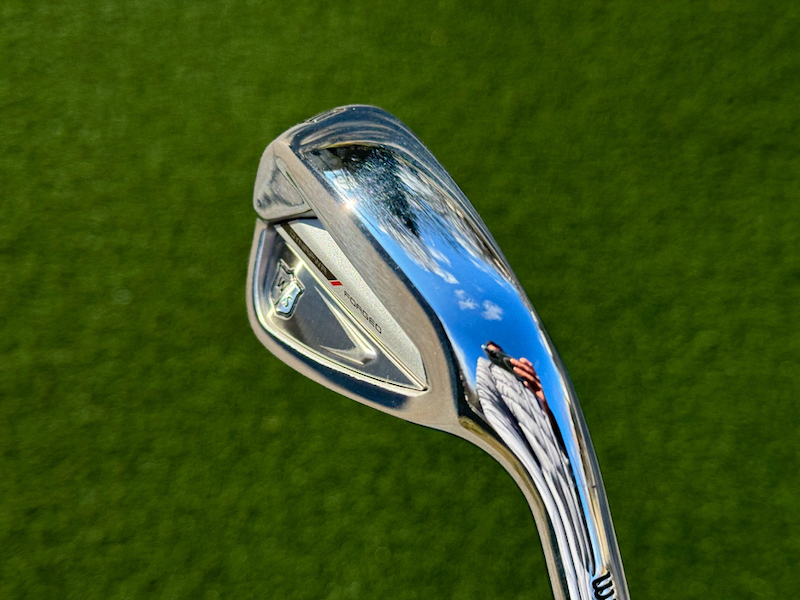
These types of irons are often the proverbial “just right” clubs that Goldilocks would be looking for, which is why we’ve seen such a strong shift towards them in recent years. The Dynapower Forged are constructed of 8620 carbon steel and are just compact enough to feel like a better players iron, yet they still provide a substantial boost in both distance and forgiveness over something like the Staff Model CB’s.
Wilson Dynapower Forged Irons – Key Technologies
We had a chance to talk with Wilson ahead of this release and asked them to give us a brief overview of the Dynapower Forged irons and what technologies they felt would help golfers the most.
Harry Nodwell, Product Line Manager, Pro Equipment, told us that, “The Dynapower Forged is the most powerful players distance iron we have ever made. Using AI, we’ve optimized both the Power Hole configuration and thicknesses across the face to maximize flexion on impact and create faster ball speeds. The weight savings from our updated Power Hole configuration allows us to drop the CG lower into the head and push more weight for the toe, creating an extremely forgiving and accurate iron while maintaining distance and speed.”
AI Designed Variable Face Thickness

Like many other companies, Wilson is utilizing machine learning, more often described as AI to the masses, in their quest to create the fastest and most forgiving iron possible. At the moment, they are calling it Dynapower AI modeling. The company describes their process by saying they, “analyzed thousands of permutations to identify the perfect variable thickness option for each section of the face to make the whole face faster while maintaining high MOI for mishits.”
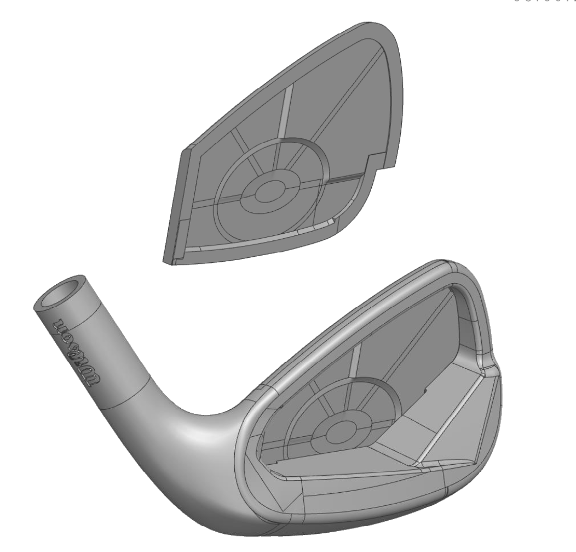
There’s certainly a lot of give and take here, especially with an iron in this segment, as you not only have to provide a measure of speed, but also consistency in things like trajectory and distance control. As if that isn’t hard enough, companies must deliver something that sounds and feels good too. In Wilson’s case, they do that, at least in part, with a high quality, 8620 Carbon Steel. Anyway, finding the right recipe can’t be easy, but machine learning certainly makes the process more efficient. We’ve already seen hints of “AI weariness” among our readers, even though its application is still in its infancy. However, it’s our opinion that though we may be tired of hearing the same buzzwords repeatedly, the minor annoyance is a small price to pay when you consider the potential benefits the technology offers.
New Power Hole 3.0 Configuration

Power Holes are a carryover technology that Wilson has utilized for years now. While we’ll again kindly suggest that the company finds another name for this feature (Power Channels?), it’s an effective tool in iron design for several reasons. While we’ve seen this feature in many past Wilson irons, with the application ranging from subtle to chaotic (we’re looking at you C300’s), the 3.0 version has been tweaked a bit from the D9 Forged irons. It’s relatively understated, but a close look shows that the toe side’s Power Hole is now lengthened, likely in a quest to provide better performance on that portion of the face.

That of course begs the question: What performance benefits do Power Holes provide? There are a couple things they do, but probably most notable is that they allow the face to flex easier, resulting in higher ball speeds. You’ll see in the graphic above that Wilson has designed them to provide faster speeds in areas most commonly impacted by amateurs. Additionally, by removing heavy carbon steel from the iron and replacing it with a lightweight TPU material, club designers have discretionary weight that they can position elsewhere in the head, optimizing things like center of gravity and MOI.
Low Center of Gravity and High MOI
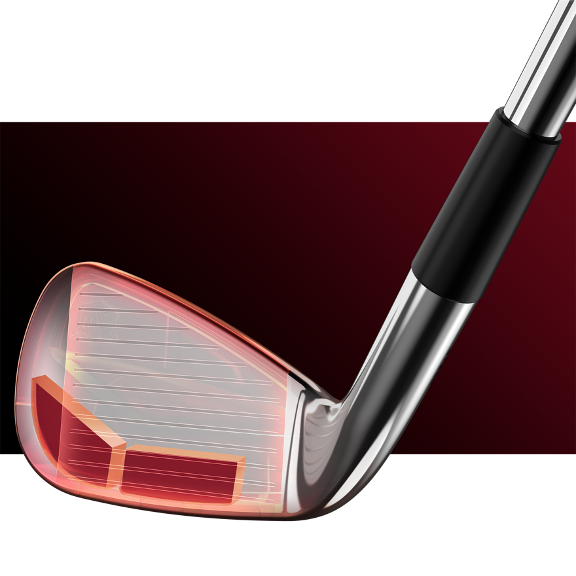
As we just alluded to, the new Power Hole 3.0 configuration gave designers the ability to manipulate the center-of-gravity and MOI properties of the Dynapower Forged irons. As you might expect, a low CG is in play here, as these stronger lofted irons are intended to launch the ball high and fast. However, a substantial amount of weight has also been pushed out towards the toe. In reality, this often makes the sweet spot closer to the true center of the face, but it also enhances club face stability on toe impacts, by far the most common misses a typical amateur will experience.
Looks, Feel, and Performance

In the players distance category, looks and feel can’t come as an afterthought. While distance and forgiveness are both important, a large subset of consumers demand an iron that at least shares some resemblance to something we see Tour players using. Smaller heads, less offset, thinner top lines, and cleaner cavities are all in high demand, if performance doesn’t suffer.
The Dynapower Forged irons are quintessential Wilson. Even with the new name, it would be almost impossible to mistake them for something else. Stalwart design choices like an abundance of chrome, soft lines, a high toe, and rounded edges are all present and familiar. The entire package made for an exciting unboxing. The chrome finish, which we admit does come across to some consumers as old-fashioned, is striking at first glance. The mirror finish absolutely gleams in the light, though fortunately the grooved portion of the face is softened with a satin finish to reduce glare.
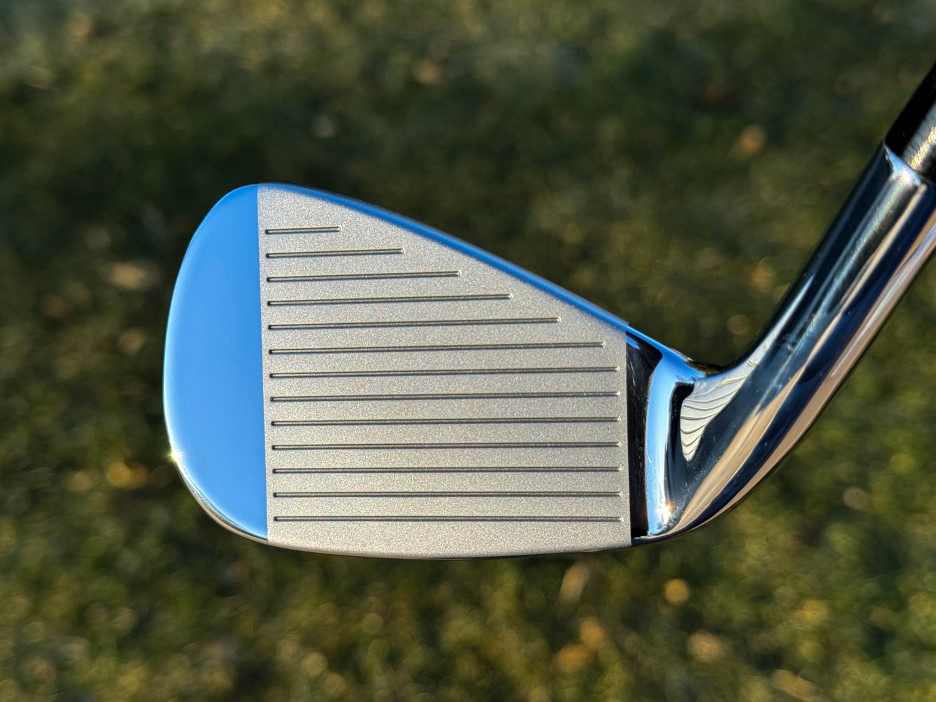
Without perspective, it’s difficult to grasp size, so at some level you’re going to have to take our word for this until you see them yourself, but the Dynapower Forged definitely qualify as “compact” irons, at least generally speaking. If you’re more familiar with game improvement irons they’ll seem quite small (the address picture below should illustrate that) without being overly intimidating. If you’re used to players cavity back irons, they’ll seem a bit larger without approaching “oversized” territory. Again, we’ll refer back to Goldilocks and her love of the middle ground.
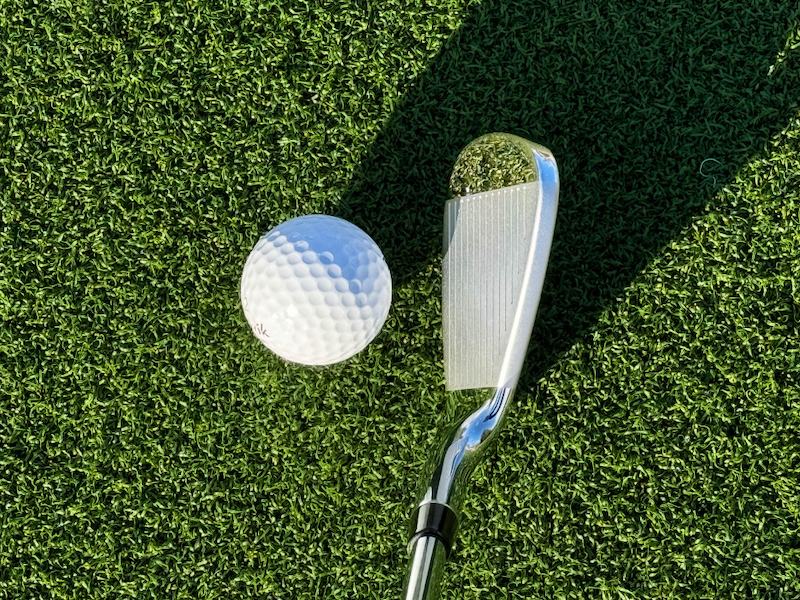
A moderately thin topline and pleasingly low amount of offset are the first things we noticed when addressing the ball with the Dynapower Forged irons. In fact, a quick survey of Wilson’s competitor’s shows these irons have either the same or less offset than anything in their class. While the topline is on the thin side, a gentle softening of the edges could do wonders for its appearance. In all, it’s our belief that anybody looking for irons of this type would find plenty to love about the Dynapower Forged at address.

The shaping of the Dynapower Forged cavity will look very familiar to anybody that saw the D9 Forged irons in hand, albeit with some subtle modifications in shaping. Though certainly not cavernous, the cavity makes us feel like there will be a reasonable amount of help with off center shots. We still can’t love the shortened DYNAPWR logo, especially on an iron of this type. It’s not so distracting that it detracts from the overall look of the iron, but it really does nothing to contribute to it. Also, we can’t help but wish the blank Wilson Staff shield seen on the 2024 Staff Model irons found its way to the Dynapower Forged. Of course, anybody can find nits to pick if they stare at something long enough, and we found ourselves staring at these irons quite a bit. That should tell you how impressed we were with the overall package.
Unfortunately, due to shipping schedules and a quickly approaching embargo date, we couldn’t spend more than a brief amount of time working with the Dynapower Forged irons before publication, so we encourage you to follow along on our forums for more performance feedback. Early indications showed they should perform exactly as advertised, with the speed and launch angles we’d expect to see from an iron of this type. The thing that stood out most was the outstanding feel at impact. It was a breath of fresh air in many ways. Without resorting to clichés, the 8620 forged face, smaller cavity, and weight placement came together to create a solid and responsive sound at impact that didn’t bleed into the realm of being artificially soft. Sound and feel are subjective, but we have a hunch anybody trying these irons out will have a lot of good things to say about them.
Fit AI Technology

Wilson’s Fit AI process is just hitting fitting centers now. While we haven’t had a chance to try it out, there is some potential in its use. Golfers will take shots using a special club that has an integrated sensor capable of measuring 12,000 data points per swing. Afterwards, the Wilson Black Box Algorithm will use a set of metrics including shaft plane, shaft load, wrist hinge, club face closure, and swing tempo to make a club and shaft recommendation.
The company notes that, “The Wilson Fit AI technology accurately gathers your individual swing characteristics and runs them through our proprietary machine learning algorithm. What makes this system so unique is the algorithm continues to optimize and learn in real time as golfers from around the globe input their swings. From there, Wilson Fit AI makes a custom iron build recommendation, and the app will provide a head, shaft, grip, length, and lie recommendation that maximizes both your performance and playability.”
According to Wilson, “Dynapower Forged is just one of five Wilson iron offerings that can be recommended by Wilson Fit AI. We anticipate many amateur golfers being fit into Dynapower Forged irons, as it gives them a great blend of playability, distance and forgiveness.”
Specifications and Details

- Pricing: Steel $999.99 USD ($1,299.99 CAD) / Graphite $1,099.99 USD ($1,399.99 CAD)
- Presale begins February 13, 2024.
- Available at retail locations March 5, 2024.
- More information at www.wilson.com





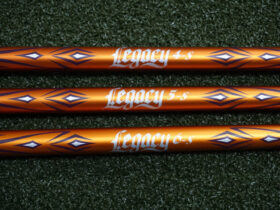






I get that. Based on your comment, I’d go with the heavier KBS?option.
Huh? I’m a little lost here…
My initial post was about my curiosity of how the power hole to non power hole irons gap. Frank brought up the loft gaps, but I’m talking distance gaps. Im saying that you don’t know the distance gaps by focusing on the loft gaps. Too many focus solely on loft gaps. Once you hit them, you see the gaps, which is one of the things we can all discuss in this testing.
I ordered my set lofts bone stock to experience it all in the testing, I’m excited to see what’s what and discuss it with everyone! It’s going to be a ton of fun.
Keep in mind, shaft weights are shaft weights, but it is the swing weight which most golfers notice. Those will still be brought to their standard specs when built with the lighter shafts.
TT DG has always been a “catch all” shaft of sorts, when certain swing parameters are in play. It’s a safe shaft that has been around forever. I’m never really surprised when I see it pop up.
Sure, but the weight also impacts keeping it on plane, tempo, etc. (All things I know you know.) If I’m used to the heavier I worry about dropping so much total weight.
Swing weight impacts all those things too.
Think of it this way, if you drop 15g, you’re dropping literally three nickels. Some are absolutely that perceptive to such a small change, but more times than not it’s the paralysis mentally of that change that has the impact.
We are all different for sure, I just think sometimes we get hung up in the minutia. Of course we are on an internet golf forum… ?
I think it’s also important knowing that 15gm weight difference is also the raw uncut shaft weight as well, before its tipped and final length trimmed. Then we get into the swing weight discussion again.
Funny you say this, generally speaking, i try to not worry about any of that stuff past a proper fit by shaft flex and length. The rest, i have enough trouble thinking about the next shot, let alone all the other stuff.
Stop it. ?
Hahaha, I get it, trust me. Golf was way simpler before I knew the things I do now! ?
I’ll let myself out ?
Dumb question maybe. I know yardage gaps are always the answer. I’ve understood that from years of loft jacking threads.
But don’t manufactures dial that in within a set? Or at least for the majority of golfers?
Do you guys mind moving that to the PM with @Jman
People are going to find this for reviews and 2 pages of why someone can’t drop a few grams makes it hard for others to follow.
Much appreciated
It’s been quite a while since I’ve put a players distance style iron into the bag for more than a one-off round.
Within that though is my understanding that I don’t have the same swing I used to. I make solid spin now, when in the past that was an area that these kinds of irons presented a lot of distance for me, but at times I struggled for descent angle to hold like I wanted.
That’s a big question for me here I can’t wait to dive into.
I don’t need more distance, but if it comes with well maintained spin and peak/descents, goodness knows I would take it.
Really excited to get this going
My initial thought was to have the shorter irons bent a little weaker to match the lofts I’m used to but I’ll be ordering stock lofts because it’s better to test them like Wilson recommends so I can experience any odd gapping and adjust from there. I had to bend a couple of my ZX blended set to get the gaps right.
What irons are you currently playing? How are these irons different from what you currently play? And What are you expecting to see from these compared to what you currently play?
View attachment 9261326View attachment 9261327View attachment 9261328
And the soles of the 7i and 8i
View attachment 9261329
The profile is a little different but overall the DPFs are right there in terms of size with many very popular offerings. I did notice the soles were a little bigger but a) they were not “big”; b) you don’t see it at address (or anywhere else unless you are looking for it); and c) I suspect that will be a net positive for the target audience in terms of playability.
I spent some time on an outdoor trackman comparing feel in 7i vs 8i. I have some thoughts but they are early and these were not optimal shafts for me so I think I will hold this for now…I have some ideas for testing this later on.
I play the 2018 Apex irons shown in my signature.
Great question. The DPFs are in the same category of clubs and they both used AI, so I’m expecting to see a lot of the same things – distance, forgiveness, feel, small package. There are in the weeds design and build differences.
I really did not come into this testing with any expectations. I’m interested in seeing how the DPFs deliver on distance, forgiveness, feel and size, and exploring how the OEM achieved it.
LOVE this question!
@tequila4kapp
@PiratePenguin
@tahoebum
@JW Smoove
@blugold
I play the Srixon ZX MKii combo set in my signature. I’m expecting these DPF’s to offer a bit more distance and forgiveness especially with the shorter irons. Distance control and being able to flight the ball up or down is important and I’m hopeful theses will excel in those areas. With the thin AI face I’ll be on the lookout for those occasional hot iron shots that fly farther than wanted.
My current set is the newest Apex Pro from Callaway, the "Players Distance" offering. I haven’t had many rounds with those, I got them last year near the end of the season. So far, they have played like the Apex Pro 21s I had. Before those, I played Wilson Staff Tour V6 irons and LOVED them.
The Dynapower Forged are Wilson’s players distance iron. Just based on some pictures, I expect these to be more distance than players. The Callaway’s have a more brushed finish and look very contemporary, the shiny chrome on the Wilson’s look very traditional, but the Power Holes look contemporary. In the bag, they are going to look interesting.
I would be lying if I said I wasn’t disappointed that we get 5-GW because that leaves an Apex Pro 4i in the bag. Maybe that will be a nice option to remind me of that offering and make comparisons easier. I use my 50° a lot, so a set wedge on those delicate swings will be an interesting change.
Currently playing Callaway Apex Pro ‘23. I expect the Dynapowers to be more forgiving and a little longer (I think they’re a degree stronger lofts), but maybe not as snappy turf interaction as the Pros. Possibly higher ball flight but maybe not. Mostly the forgiveness, especially to side and slightly fat. Otherwise the Pros are pretty forgiving as they are for what they are.
I forgot to answer!
Im coming from splitting time with ‘24 Apex Pro CB/MB’s and Edel SMS Pro’s, so, some pretty compact irons with a lot of demand.
I don’t hit my setups short by any means, but I’m expecting more distance here, also more height, as well as less spin.
Biggest thing for me is going to be keeping an eye on the turf interaction as well as the overall consistency of carry numbers through the set, ESPECIALLY where they go from power holes, to solid soles.
It’s interesting that I had a conversation at a store the other day about irons of this ilk. He said he would play them because of “hot spots”.. I am not sure that is a thing anymore but will be interesting to hear if this pops up..
It’s really not a thing anymore, but I think the Burner 2.0’s scarred many forever into thinking it is haha
My swing is inconsistent enough that if I ever got the odd ball that flew substantially longer, it’s more of an accident caused by a good swing.
Same
100% this. I was seeing it this morning when I hit them this morning. All distance variance was me and my wonky swing.